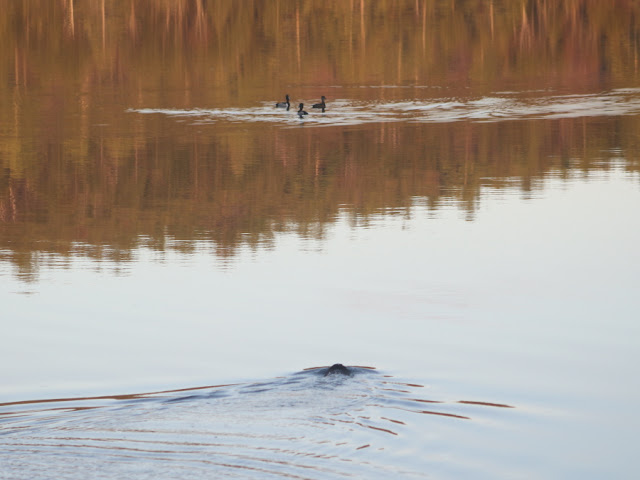As the weather warms more and more summer birds are arriving. This week I heard my first pine warbler, one of the earliest warblers to appear each year, and checking my notes, this was three weeks earlier than last year. Pine warblers spend their time high up in the tree branches so I wasn't able to see any, but there are many. As I walked along I would hear one loud and close, and then far away in the distance, another would respond, sending its report right back after the first one finished its message. As I got close to the second one, I could hear a third off in the distance responding to the second. I believe what's going on is that each bird has staked out its nesting territory and is proclaiming its domain with its song. If it hears another pine warbler far away, all is well. But if another gets too close, there will be an altercation. I imagine a checkerboard pattern of pine warbler nesting sites throughout the forest.
What's interesting is that within this range there may be a dozen other bird species doing the same thing, and they are perfectly comfortable with sharing their territory with different species of birds, just not with those of the same species.
Here's a picture I took of a pine warbler back in 2013 when a male perched on a dead branch with no leaves to hide behind.
Pine warblers are unique among warblers in that seeds make up a large part of their diet, especially, perhaps as expected, pine seeds. If you keep bird feeders out at this time of year and want to try to attract a pine warbler, try hanging your bird feeder high up, maybe 30 or 40 feet above the ground (that will also discourage the bears). Having a diet of seeds lets pine warblers arrive earlier in the spring than birds that rely on insects, and pine warblers will starting breeding soon - thus the claiming of territory at this point in the year.
I mentioned seeing ring-necked ducks last week; on one kayak trip I came upon an interesting combination of three ring-necked ducks and a lone female merganser.
Earlier the same day I watched what was likely the same three ring-necked ducks, two males apparently courting a single female early in the morning.
A curious beaver on patrol seemed to be heading in that direction to see if there was going to be a show to watch as they fought over her attention.
I often struggle to differentiate between beaver and muskrat, but I'm pretty sure I saw a couple of muskrats this week. At morning or night it's a pretty good bet a swimming rodent is a beaver, especially if it's on a high speed mission; muskrats are more likely to be active during the day and often are a little more erratic in their swimming patterns. Muskrats are also smaller, but the sure way to tell is by the tail, as the muskrat has a thin rat-like tail versus the wide, flat paddle of the beaver tail. I think this medium size rodent, swimming along the shore at 2:00 in the afternoon, was a muskrat:
 |
| A muskrat enjoys a warm spring afternoon. |
In addition to the ring-necked ducks, we were visited by several groups of buffleheads this week.
 |
| Mrs. Bufflehead. |
I always enjoy seeing these pretty birds and watching their dives - they are so quick as they upend themselves and plunk straight down into the water.
One other neat observation was made by Tom Crane back on March 29th, before ice-out: a pair of common goldeneyes visiting Wicwas, diving within a small channel that had opened up along the northern edge of the lake.
 |
| A pair of common goldeneyes fish between the ice sheets. |
Tom noted "The male's head really gleamed a beautiful green when the sun hit it. We have also had a pair of Wood Ducks hanging around the cove longer than usual. We have also had a few of what look like Buffleheads around lately, as well as passing Mergansers. An interesting time of year."
Hopefully we'll get an improvement from the recent chilly, wet weather so we can get out and see more of the migrating birds. It won't be long before the birds heading for Canada will have departed the Lakes Region.
 |
| A bufflehead takes off for places unknown. |
But they'll be back again next year.







No comments:
Post a Comment